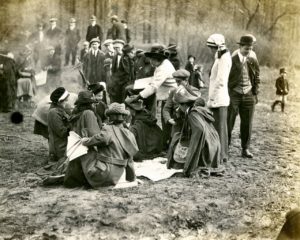
In 2015, Nancy and Bill Steel’s family photo album yielded early 20th-century images of what may have been Riverton’s first swimming pool, H. McIlvain Biddle’s iceboat plying the Delaware River, a bi-wing seaplane afloat near Riverton Yacht Club, and a group of apparent suffragists lunching at Haine’s Pond, Burlington Pike.
Visual treats, indeed, despite the lack of accompanying notes that might have given them more context.
In a year in which a woman is the first female presidential nominee of a major party, the enigmatic photos of crowds walking, singing, and bearing “VOTES FOR WOMEN” signs at several Burlington County locales warrant revisiting the Steel photo album.
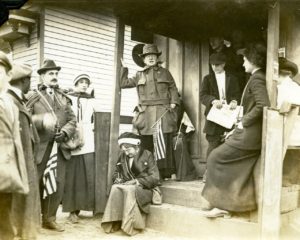
Peculiarly referred to in captions as Col. Ida Kraft* (spelling varied), Corp. Martha Kaltschkin*, and Gen. Rosalie Jones, the women, and their “Pilgrim Army” had piqued my interest. (see CORRECTIONS below)
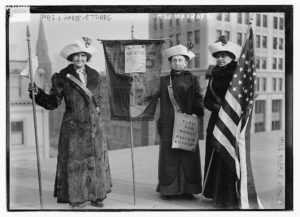
Some newspaper research and many Google hits later led me to this Library of Congress photo documenting the 1913 suffrage hike from New York City which culminated in an immense suffrage parade in Washington, D.C. timed to coincide with newly elected President Woodrow Wilson’s inauguration.

Newspaper accounts confirmed that the hikers did indeed pass through these parts.
Turns out, the Steel family album documents an important chapter in the long fight for women’s right to vote.
What would those pioneers think of today’s developments in the Election of 2016?
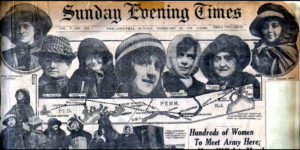
Dubbed “The Army of the Hudson” by newspapers, General Jones considered the movement of women to become enfranchised of as much importance to this country as General Washington’s celebrated crossing of the Delaware. Jones and her “pilgrims” marched 230 miles in 17 days to the nation’s capital.
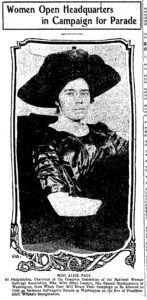
Meanwhile, Alice Paul, the acclaimed 28-year-old Quaker suffragist from nearby Mt. Laurel, had been in Washington working for the National American Woman Suffrage Association (NAWSA) since December 1912.
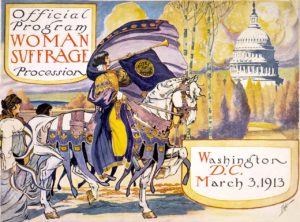 As chair of NAWSA’s Congressional Committee, she strategized, raised funds, organized, and maximized publicity for the first suffragist parade in Washington, D.C., known officially as the Woman Suffrage Procession.
As chair of NAWSA’s Congressional Committee, she strategized, raised funds, organized, and maximized publicity for the first suffragist parade in Washington, D.C., known officially as the Woman Suffrage Procession.


Imagine a parade of 8,000 marchers with 26 floats with costumed suffragists, bands, speakers, and mounted brigades led by Inez Milholland, acknowledged as “the most beautiful suffragist, dressed in Greek robes and astride a white horse as a half-million spectators clogged the Pennsylvania Avenue route to the White House.

The nation observed the spectacle through countless newspaper accounts.
A later scandal asserting a lack of response by police to the violence perpetrated by suffrage opponents in the crowd fueled tremendous sympathetic publicity.
However, it was not to be until 1920 that the Nineteenth Amendment to the United States Constitution was ratified, guaranteeing no state could deny the right to vote on the basis of sex.
Some circumstantial evidence suggests that perhaps at least some Rivertonians took part in the women’s suffrage events of 1913.
- Alice Paul graduated from Swarthmore College in 1905, a Quaker institution co-founded by her grandfather, Judge William Parry, an important figure in local history. Accounts inform us that, at the parade, she marched with a contingent of Swarthmore friends.
- Many members of prominent Riverton families had attended Swarthmore including Beulah and Susanna Parry, Hetty Coale Lippincott, Martha McIlvain Biddle, Clara Atlee, Ruth Hunt Conrow, Abigail Mary Ellsworth, Esther Fisher Holmes, Anna Lippincott Miller, and Elisabeth Somers Williams.
- Alice Paul’s father, William Mickel Paul, was vice-president of the Riverton and Palmyra Water Company and owned stock in the Tacony-Palmya Ferry Company.
- Perhaps not coincidentally, the record also shows that Riverton clubwomen such as Mary Van Meter Grice, Mrs. D. Henry Wright, Mary L. Thomas, Amelia Coale, Edith Coale, and others were involved in the women’s movement.
- In 1904, Helen Lippincott, Swarthmore alum and Porch Club Charter Member, called for the formation of a Suffrage Section, or department, at the Porch Club. Later she served as a delegate to the November 1912 National Convention of the Women’s Suffrage Association at which Alice Paul was an alternate delegate.
Suffice it to say that the timing and locations allow for the possibility that at least some Riverton women helped advance the cause of women’s rights.

Here’s my question: Are the pictures in the Steel album because an ancestor or acquaintance participated in the march? Further, is there a deeper connection to Riverton history somehow?
The captions do not say and the Mr. and Mrs. Steel do not know.
We could use a hand with this one, Readers. – JMc
Added 11-4-2016: See a more detailed version of this story in the November issue of the Gaslight News.
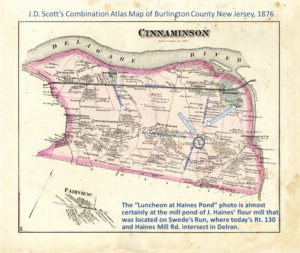 Added 4-7-2019: Roger Prichard explains where the luncheon at Haines Pond took place. Give the large file a sec to load.
Added 4-7-2019: Roger Prichard explains where the luncheon at Haines Pond took place. Give the large file a sec to load.
*Corrections 7-7-2021: Further research has confirmed that the captions included with the original photos incorrectly spelled Craft with a “K.” Also, Martha Kaltschkin should be spelled Martha Klatschken and Alice Freeman was misidentified as Elisabeth Freeman. Thank you to Jane Swersey who put us on the right track.
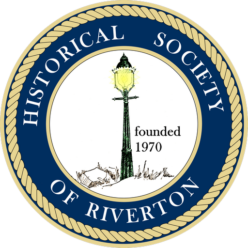
The “Luncheon at Haines Pond” photo is almost certainly at the mill pond of J. Haines’ flour mill that was located on Swede Run, where today’s Rt 130 and Haines Mill Rd. intersect in Delran. (Ever wonder where the mill actually was, that Haines Mill Rd. was named after? Now you know!)